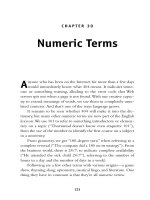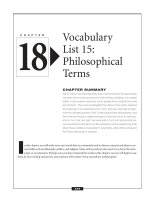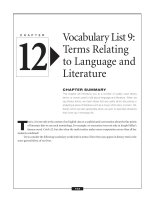Grammatical terms
Bạn đang xem bản rút gọn của tài liệu. Xem và tải ngay bản đầy đủ của tài liệu tại đây (8.46 KB, 1 trang )
Grammatical terms
Person
The grammatical category which is used to distinguish participants in a conversation. English distinguishes three
persons.
The first person represents the speaker or speakers. The pronouns are I and we. The second person represents
the hearer or hearers. The pronoun is you. The third person represents everything and everybody else. The
pronouns are: he, she, they and it.
Phrasal genitive
The construction in which the preposition of and a possessive form appear. Examples are: a friend of mine, that
brother of Peter’s etc
Phrasal verb
A complex verb form consisting of a simple verb and an adverb particle. Examples are: make up, put off, put
away, turn on etc.
A phrasal verb differs from a prepositional verb in three respects.
1. The particle in a phrasal verb is stressed. The preposition in a prepositional verb is not stressed.
2. The particle of a phrasal verb can be moved to the end. The preposition of a prepositional verb cannot be
moved to the end.
3. You cannot put an adverb between the two parts of a phrasal verb. An adverb can go between the two
parts of a prepositional verb.
Phrase
A sequence of one or more words which forms a grammatical unit. There are five principal types of phrases in
English: noun phrase, verb phrase, adjective phrase, adverb phrase and prepositional phrase.
Plurale tantum
A noun which is plural in form, even though it may be singular in sense. Examples are: oats, cattle, pants,
scissors and tweezers.
Stay on top of your writing! Download our grammar guide from www.englishgrammar.org to stay up-to-date.
Powered by TCPDF (www.tcpdf.org)









